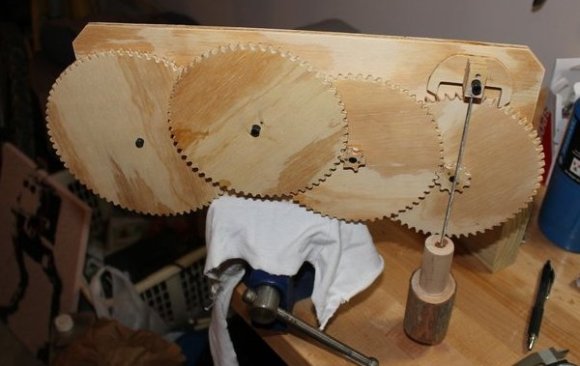Electronics are undoubtedly the basis for our modern society. Leaving out transistor-based devices, and a mechanical clock would be one of the most intricate devices man has come up with. As a Mechanical Engineer, I thought it would be a fun challenge to design and build my own gear-driven clock.
Because clocks have obviously been invented, I wouldn’t be starting from scratch, and I don’t think I could have figured out an escapement on my own. I explain my initial clock escapement and gear reduction design thoughts in this post, and originally getting the escapement to work was my biggest fear.
As seen in the first video after the break, the escapement gear is still a big problem, but not really for the reason I expected. The shaft that the gear sits on seems to be bent, so it allows the escapement to “go free” for part of it’s cycle, losing any sense of accurate timekeeping. Be sure to also check out the second video, especially around 1:50 when I show what happens when an escapement gear goes much faster than a normal clock.
[youtube http://www.youtube.com/watch?v=UFFODaXkz58%5D
[youtube http://www.youtube.com/watch?v=W_TzPqYTH6E%5D
This clock project has been really fun so far. Right now I’m planning to step back and redo the main frame, and put in some better gear axes. Considering all the equipment we now have, it’s really amazing how people were able to build much better clocks than what I could make hundreds of years ago.

















you may need to use a popsicle stick because the rod is probably flexing and buffering some of the motion
That’s a good idea, I’ll have to try that (or some similar spacer).
love it
Thanks Alex!
Yes… love it. I’d like to make a working wood clock myself one day.
It looks like the plywood you’re using for the gears is chipping away at the edge where the gear teeth are. Consider using a different material that won’t flake/chip – maybe MDO or solid wood?
Thanks. Definitely a prototype at this point, but yeah a better wood could help this. Was thinking it’d be cool to get it laser cut out of metal if I get it perfected, but who knows if that will happen?
Are the “teeth” (pawls”) on the escapement long enough?
John Harrison did it first :-)
…in 1713!
http://www.youtube.com/watch?v=bUxZlSVEAk0
Nice work, though!
Haha, thanks! Really unbelievable what people were able to accomplish 300 years ago!
More appealing to have the left two gears face out, so all of the train can be seen.
Hmm, not a bad idea…
I’m surprised we haven’t been bombarded with “Not another Me Too effort, this is just reinventing the wheel, it’s not a hack, because John Harrison did this in 1713, c’mon hackaday Editors, show us some real hacks”
Nice work. I have repaired a many old clocks and have a few suggestions for the escapement. Firstly (ditto the first commenter) your pendulum has too much front to back free movement – it needs to move in one plane only – from side to side. A more rigid pivot point or pendulum should fix that. Secondly if you have a close look at some old clocks you will see that the top part of the pendulum is actually a strip of spring steel and hits between 2 close fitting stops below the pivot point. This introduces a slight amount of ‘whip’ so that the pendulum continues on slightly and then uses some of the spring to return. I have used a piece of steel from a razor blade for this in the past. Thirdly – you might need some minor tweaks to your escapement. Escapement anchors are shaped to use the force of the cog to push the escapement away. Also some escapements are not centered at rest – they are cocked to one side. The teeth of the cog and escapement also need to be very fine – you might need to use some hardwood for the anchor.
Very cool. Time flies when you’re escapement gear is off. I could definately see you building an all wooden gradfather clock.
First time poster long time reader, a while ago didn’t some one post an old timey video on the mechanics of how a clock works? I’ve been trying to find it with no luck.
please tell which gear for hour and which gear for minute in vedio which show in this page